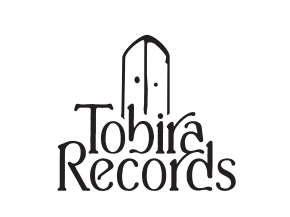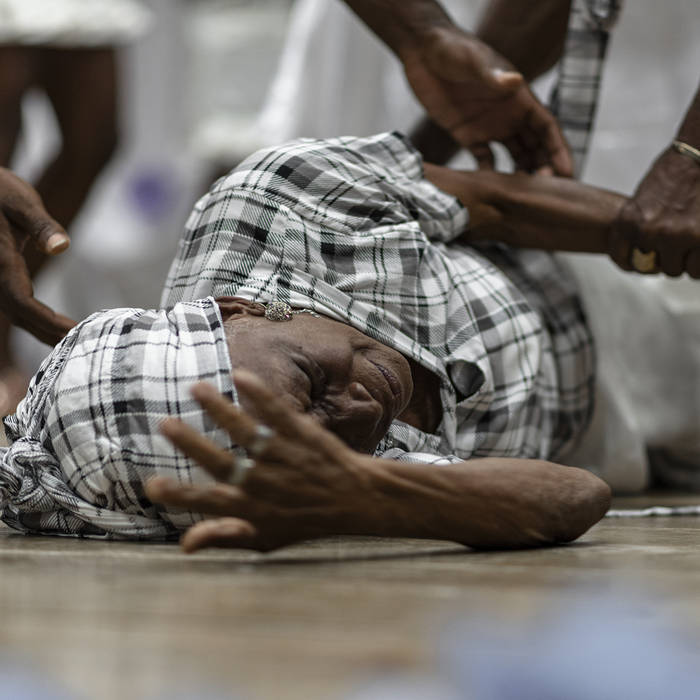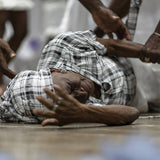Txema González // Alabaos y Gualíes: Dirges and Funeral Rites in the Afro-Colombian Pacific TAPE
- Availability:
フィールドレコーディング作家Txema Gonzálezが、2025年6月にイギリス・ロンドンの発掘専門レーベルDeath Is Not The Endからリリースしたカセットです。
アフロ・コロンビアの葬送歌12曲を収録。
※デジタル音源を無料でお送りいたしますのでお気軽にご連絡くださいませ
以下、レーベルによる解説です。
"gualíes、alabaos、levantamientos de tumbaは、アフロ・コロンビア太平洋地域のコミュニティに典型的な埋葬儀礼である。この儀式は、コミュニティのメンバーが亡くなったときに死者とその親族に付き添い、亡くなった子供(gualíes)や大人(alabaosとlevantamientos de tumba)の魂が永遠へと旅立つのを助けるために行われる。これらの慣習の主な目的は、共同体としての自分たちを再確認し、家族、友人、隣人、その他参加者全員をひとつにする連帯の行為に基づいて、死にまつわる悲しみを和らげ、対処する手助けをすることである。
アフロ系住民のコミュニティにとって、死はあの世への入り口であり、先祖である精霊が存在する場所である。私たちは、死は人生そのものの一部であり、「主の永遠の臨在を享受する」ために必要なステップであると理解している。私たちの多くにとって、生者と死者の間に、人の死によって終わるのではなく、単に変容する関係があることは疑いない。メディオ・サン・フアンのアフロ・コミュニティでは、死は創造主との再会、罪に対する勝利を意味する。
ゴンサロ・トーレス神父によれば、生者と死者のつながりという考え方は、アフリカの伝統と結びついている。そして、去る者は残る者を待ち続ける。同じ理由で、あなたはいつも、彼らを悼むのではなく、彼らに別れを告げなければならない--ある時点では、彼らを悼むこともあるが、まずは、彼らが安らかに去ることができるように、彼らが休むことができるように、彼らが共同体を乱すことなく、安心してあなたを待つことができるように、彼らに別れを告げるのだ。
このように、死はステップであり、来世に向かう道のりの旅であることを理解し、準備と付き添いが必要なのである。死後の世界への通路は、魂が肉体を離れる死の日から始まり、魂がこの世を去る準備が整う9日後まで、数日間続く。そのため、子供の場合はグアリ、大人の場合は通夜、ノヴェナ、墓上げ、ノヴェナの完了というそれぞれの儀式を執り行うことは、私たちにとって非常に重要なことであり、それは、亡くなった人々の魂のために、神の前で別れを告げ、執り成すことなのである。"
レーベルその他作品はこちら /// Click here to see more Death Is Not The End releases available at Tobira.
--------------------------------------
Ask us for digital files.
Cassette in norelco case.
Tracklist:
1. Juana (Andagoya) 03:10
2. Allá arriba (Docordó - Infantil) 02:27
3. Padre misericordia (Bojayá Resistencia) 05:28
4. Levanten la tumba (Andagoya) 02:58
5. Yo sembré mi mata (Docordó) 04:41
6. El reloj (Tadó) 05:00
7. Buenas noches mis dolientes (La Encharcazón) 04:38
8. Despierta mortal despierta (Dipurdú) 02:58
9. El alma se va (Andagoya) 04:00
10. Tío Pacho (Docordó) 02:06
11. Repicaron las campanas (Docordó - Infantil) 05:04
12. Un sábado de mañana (Tadó) 06:09
Death Is Not The End:
"The gualíes, alabaos and levantamientos de tumba are burial rites typical of the Afro-Colombian Pacific communities. The rituals are performed to accompany the dead and their relatives when a member of the community dies, helping the deceased children (gualíes) or adults (alabaos and levantamientos de tumba) in the passage of their souls to eternity. The main objective of these practices is to alleviate and help in the management of grief related to death, based on acts of solidarity that allow us to reaffirm ourselves as communities and unite family members, friends, neighbours and others with all those who participate.
For the Afro-descendant communities, death is a gateway to the other world, a place where the spirits, our ancestors, are present. We understand death as part of life itself and a necessary step "to enjoy the eternal presence of the Lord" (1). For many of us, there is no doubt that there is a relationship between the living and the dead that does not end with the death of the person, but is simply transformed. Among the Afro communities of Medio San Juan, death means reunion with the Creator, triumph over sin.
The Chocoan researcher Ana Gilma Ayala sums the alabaos as a way of "accompanying not only the mourners but also the deceased.
For us, in our worldview, there is the idea and it is very African - that there is a road to the afterlife, a road on which the deceased needs accompaniment. So one way of accompanying them is through prayers and songs" (2)
According to Father Gonzalo Torres, the idea of links between the living and the dead is linked to our African heritage: "these manifestations are based on the idea of the African muntú, of the large extended family, which is not only lived here but is also transferred to the afterlife. And those who leave remain waiting for the one who stays. And for the same reason you always have to say goodbye to them rather than mourn them - although at some point you also mourn them, you first say goodbye to them so that they can leave peacefully, so that they can rest, so that they can wait for you in peace and not disturb the community" (3)
Thus, understanding that death is a step, the journey of a path towards the next life, preparation and accompaniment are necessary. The passage to the afterlife lasts several days beginning on the day of death, when the soul leaves the physical body, and ending nine days later when the soul is ready to leave this world. That is why the performance of each of these rites, the gualí for a child, and the wake, the novena and the raising of the grave or completion of the novena for an adult, are so important for us, as it is our way of saying goodbye and interceding before God for the
souls of those who have passed away."
Artist : Txema González
Label : Death Is Not The End
フィールドレコーディング作家Txema Gonzálezが、2025年6月にイギリス・ロンドンの発掘専門レーベルDeath Is Not The Endからリリースしたカセットです。
アフロ・コロンビアの葬送歌12曲を収録。
※デジタル音源を無料でお送りいたしますのでお気軽にご連絡くださいませ
以下、レーベルによる解説です。
"gualíes、alabaos、levantamientos de tumbaは、アフロ・コロンビア太平洋地域のコミュニティに典型的な埋葬儀礼である。この儀式は、コミュニティのメンバーが亡くなったときに死者とその親族に付き添い、亡くなった子供(gualíes)や大人(alabaosとlevantamientos de tumba)の魂が永遠へと旅立つのを助けるために行われる。これらの慣習の主な目的は、共同体としての自分たちを再確認し、家族、友人、隣人、その他参加者全員をひとつにする連帯の行為に基づいて、死にまつわる悲しみを和らげ、対処する手助けをすることである。
アフロ系住民のコミュニティにとって、死はあの世への入り口であり、先祖である精霊が存在する場所である。私たちは、死は人生そのものの一部であり、「主の永遠の臨在を享受する」ために必要なステップであると理解している。私たちの多くにとって、生者と死者の間に、人の死によって終わるのではなく、単に変容する関係があることは疑いない。メディオ・サン・フアンのアフロ・コミュニティでは、死は創造主との再会、罪に対する勝利を意味する。
ゴンサロ・トーレス神父によれば、生者と死者のつながりという考え方は、アフリカの伝統と結びついている。そして、去る者は残る者を待ち続ける。同じ理由で、あなたはいつも、彼らを悼むのではなく、彼らに別れを告げなければならない--ある時点では、彼らを悼むこともあるが、まずは、彼らが安らかに去ることができるように、彼らが休むことができるように、彼らが共同体を乱すことなく、安心してあなたを待つことができるように、彼らに別れを告げるのだ。
このように、死はステップであり、来世に向かう道のりの旅であることを理解し、準備と付き添いが必要なのである。死後の世界への通路は、魂が肉体を離れる死の日から始まり、魂がこの世を去る準備が整う9日後まで、数日間続く。そのため、子供の場合はグアリ、大人の場合は通夜、ノヴェナ、墓上げ、ノヴェナの完了というそれぞれの儀式を執り行うことは、私たちにとって非常に重要なことであり、それは、亡くなった人々の魂のために、神の前で別れを告げ、執り成すことなのである。"
レーベルその他作品はこちら /// Click here to see more Death Is Not The End releases available at Tobira.
--------------------------------------
Ask us for digital files.
Cassette in norelco case.
Tracklist:
1. Juana (Andagoya) 03:10
2. Allá arriba (Docordó - Infantil) 02:27
3. Padre misericordia (Bojayá Resistencia) 05:28
4. Levanten la tumba (Andagoya) 02:58
5. Yo sembré mi mata (Docordó) 04:41
6. El reloj (Tadó) 05:00
7. Buenas noches mis dolientes (La Encharcazón) 04:38
8. Despierta mortal despierta (Dipurdú) 02:58
9. El alma se va (Andagoya) 04:00
10. Tío Pacho (Docordó) 02:06
11. Repicaron las campanas (Docordó - Infantil) 05:04
12. Un sábado de mañana (Tadó) 06:09
Death Is Not The End:
"The gualíes, alabaos and levantamientos de tumba are burial rites typical of the Afro-Colombian Pacific communities. The rituals are performed to accompany the dead and their relatives when a member of the community dies, helping the deceased children (gualíes) or adults (alabaos and levantamientos de tumba) in the passage of their souls to eternity. The main objective of these practices is to alleviate and help in the management of grief related to death, based on acts of solidarity that allow us to reaffirm ourselves as communities and unite family members, friends, neighbours and others with all those who participate.
For the Afro-descendant communities, death is a gateway to the other world, a place where the spirits, our ancestors, are present. We understand death as part of life itself and a necessary step "to enjoy the eternal presence of the Lord" (1). For many of us, there is no doubt that there is a relationship between the living and the dead that does not end with the death of the person, but is simply transformed. Among the Afro communities of Medio San Juan, death means reunion with the Creator, triumph over sin.
The Chocoan researcher Ana Gilma Ayala sums the alabaos as a way of "accompanying not only the mourners but also the deceased.
For us, in our worldview, there is the idea and it is very African - that there is a road to the afterlife, a road on which the deceased needs accompaniment. So one way of accompanying them is through prayers and songs" (2)
According to Father Gonzalo Torres, the idea of links between the living and the dead is linked to our African heritage: "these manifestations are based on the idea of the African muntú, of the large extended family, which is not only lived here but is also transferred to the afterlife. And those who leave remain waiting for the one who stays. And for the same reason you always have to say goodbye to them rather than mourn them - although at some point you also mourn them, you first say goodbye to them so that they can leave peacefully, so that they can rest, so that they can wait for you in peace and not disturb the community" (3)
Thus, understanding that death is a step, the journey of a path towards the next life, preparation and accompaniment are necessary. The passage to the afterlife lasts several days beginning on the day of death, when the soul leaves the physical body, and ending nine days later when the soul is ready to leave this world. That is why the performance of each of these rites, the gualí for a child, and the wake, the novena and the raising of the grave or completion of the novena for an adult, are so important for us, as it is our way of saying goodbye and interceding before God for the
souls of those who have passed away."
Artist : Txema González
Label : Death Is Not The End





![Eucalyptus // Topology Of Time And Up Express Etc. LP [COLOR]](http://tobirarecords.com/cdn/shop/files/top1_da4c6857-1361-4498-844f-feb19819e7a6_medium.jpg?v=1764287738)
![Badge Epoch // Furry Worried Ape LP [COLOR]](http://tobirarecords.com/cdn/shop/files/ape1_0ed90321-ce90-4bfb-8f58-546e0d9d7a01_medium.jpg?v=1764287577)
